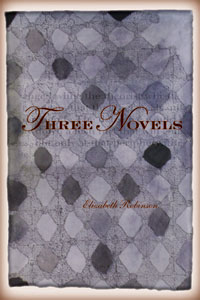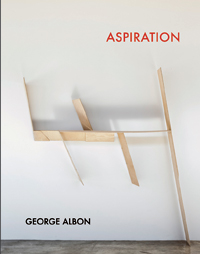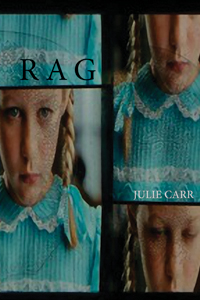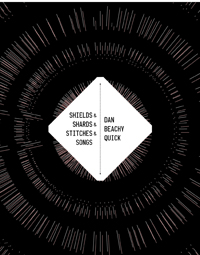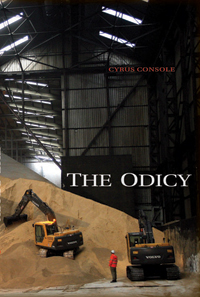Description
Three Novels revisits the terrain of the Victorian novel, entering that world with a particular affinity for the feminine within its social and physical landscape. Taking cues from three different novels, these poems show the intimacies that make “adhesive relation” through troth, kin or links to landscape. Who owns this body, this estate? Where does the woman hide and what is the empowering eros of her role? Three Novels proposes “disguise as clairvoyant,” and here the wily female body is resistant to ownership as it slips through the hidden paths and plot twists, through the downy lawns, the nocturnal byways, and the gritty train stations into the “accounts most accurate to the invention.
Elizabeth Robinson’s new and original collection recasts three mysterious novels into poetic prose fragments each of which underscores questions also raised in the novels: what is to be believed, which clues should be followed, which layer of meaning represents any form of truth…. this original and intriguing exploration also urges reading itself as a way to grasp our lives.
Martha Ronk
Part lyrical investigation, part investigative evocation, always insightful and original, Elizabeth Robinson’s Three Novels is a poetic journey into the prose delectations of the ever-wonderful Wilkie Collins and George Gissing. Just as Susan Howe’s exploration of Emily Dickinson offered readers a fresh path into her works and days, so now has Robinson traveled back into nineteenth-century England to rediscover masterpieces by two of its most quirky, unconventional giants. A real jewel, Three Novels recalls the ineffable one that Wilkie Collins conjured in The Moonstone, the mystery that T. S. Eliot referred to as “the first…and the best of the modern English detective novels.” And Robinson’s achievement of bringing fresh life to these classics, already bursting with life themselves, is a feat that deserves our gratitude and admiration.
Bradford Morrow
About the Author
Reviews
Excerpt
Elizabeth Robinson is the author of eleven books of poetry (including Three Novels). Her most recent books are The Orphan & its Relations (Fence Books) and Also Known As (Apogee Press). Robinson was educated at Bard College, Brown University, and the Pacific School of Religion. She has been a winner of the National Poetry Series for Pure Descent and the Fence Modern Poets Prize for Apprehend. The recipient of grants from the Fund for Poetry and the Foundation for Contemporary Arts, Robinson has also been a MacDowell Colony Fellow. Her work has been anthologized in the Best American Poetry (2002) and American Hybrid, along with many other anthologies. Robinson has taught at the University of San Francisco, the University of Colorado, Boulder, Naropa University and the Iowa Writers’ Workshop. She co-edits EtherDome Chapbooks with Colleen Lookingbill and Instance Press with Beth Anderson and Laura Sims.
An Interview with Elizabeth Robinson
(conducted by Rusty Morrison)
What is your personal relationship to these three Victorian novels: Wilkie Collins’ The Moonstone and The Woman in White and George Gissing’s Eve’s Ransom? Why did you choose them as your source material?
I chose these three novels because my father read the Collins novels to me when I was a child (early through late grade school). The (to me) beautiful diction of Victorian prose and the pleasure of hearing my father’s fluent reading certainly impacted my sense that I had to become a writer. Later, as my father and I shared books as ardent adult readers, we read the Gissing novella, Eve’s Ransom, at around the same time.
I wrote these poems shortly after my father’s death, so the book is both a tribute to him and his generosity to me, and a way of integrating the material into my life in a new way. As you could imagine, I didn’t really understand some of the content of these complex novels when I was a child. Illegitimacy? Victorian inheritance laws? Victorian etiquette? But the three novels are powerful to me as forms of memory, as a primary interaction with language, and particular lenses on the world.
You’ve described this collection of poems as a project in which you consider the meanings of ownership, with respect to the female body in its social and its physical landscapes. Were you aware of this intention when you began writing the poems? Or did it grow out of the process of writing? Did your relationship to these issues evolve in the process?
One way that I felt I could make this material new to myself was by looking at the role of women in these books. I first heard them, after all, as the passive listening daughter. Now I was bereft of that role and in a sense that liberated me to a new perspective. As readers of Victorian novels know, much of the plot is built around the obstacles that Victorian etiquette throws in the way of direct action and communication. This seems particularly true of the women characters who are constrained in so many ways. Yet I feel that both Collins and Gissing show real sympathy and insight into the difficulties that their female characters face. In any event, we still live in a world where women earn less than their male counterparts. More often than we acknowledge, or perhaps even register, women’s bodies and activities are monitored and hemmed in. Not long ago, a man stopped me to the street to praise me because I was dressed “modestly”!
Because of the place I found myself in vocationally and personally when I wrote these poems, I was interested in considering how a woman might, so to speak, be an agent of her own destiny while wandering through a maze.
Each of the three poem series has markedly different approach to the source material. Did you find yourself more in sympathy with one novel over another? Did you find one of the novels more difficult, or more satisfying to engage with? Did you feel there were more risks you needed to take with one over another? Did any of this impact the order you placed them in?
I wanted to make distinct formal decisions in shaping these poems so that the particularities of the books would be more evident. The Moonstone is said to be the first detective novel and so, in the poem of the same name, I wanted to alternate quasi-prose blocks that had a kind of prose-like orderliness with more open passages that addressed what I saw as the affective undercurrent of the book. Collins was also a very witty writer, and I felt that I could use the prose shape to convey some of that. “Romance” works off of Gissing’s Eve’s Ransom which is a strange little novella; it leaves the reader is a state of irresolution that is unusual for books of its era. The predicament of the heroine causes her to behave in ways that seem equivocal, perhaps not admirable, while the hero is also struggling in various ways. What interested me is that Gissing conveyed both characters with insight and a relative lack of judgement. So I began that poem trying to make the characters interchangeable, by using gender neutral pronouns, though I permitted that to shift in the end. In this era of economic difficulty (which I’ve felt personally and keenly over the past seven years), I wanted to keep a sort of open lyric structure that would consider the ways the press of social and economic constraints shape, even warp, the individual. “The Woman in White” was by far the most difficult poem for me to write because it is emotionally the most charged for me. The novel is perhaps my favorite of all novels. I find it so haunting. I wanted to create the page as a visual landscape to show the sensuous undulations of place in the novel, but also a landscape in which characters were evasive, hid, sought, preyed upon, or engaged with each other. The poem is for me full of ghosts, not just the various characters of the novel, but the active presence and voice of my father in this work. I wrote it very consciously as a way of mourning his death. That poem, then, still remains a site of vulnerability for me, and I feel I have least control over it.
Are there poets from your past, whom you have read and revered, who have influenced your work on this project?
Obviously, Collins and Gissing were the models and sources I was working off here, but Martha Ronk and Cole Swensen come to mind as extremely intelligent writers who often embark upon a book as a kind of research project that entails some element of study as well as poetic interpretation. I admire both enormously. In a different way, I would site Kristin Prevallet’s work. Her I, Afterlife, which she subtitles “an essay in mourning time” gave me permission to work through this material as both a personal and (more obscurely than in her book) political exploration.
Each of your books of poetry is very different from the last. Can you talk about your thinking about the composition of a book as a unified or complicating project? and/or can you talk about how you’ve moved from one project to the next? Are there aspects of a past project that seeded the challenges, or inspired the risks you wanted to take in a subsequent project?
Restlessness and a desire to overleap my own personal clichés influences different decisions about how to bring together a collection of poems. On the other hand, I admit that I’m an obsessive person and so some preoccupation will get under my skin and it’s sort of like scratching a poison ivy rash: you know you shouldn’t, but you can’t help it. It feels so good for about 4 seconds and then the rash just spreads.
In my first books, I was just a flailing-around-writer who wrote poems without any sense of the arc of a book. Working with Keith Waldrop as a graduate student helped me to begin to perceive the ways that poems talk productively to each other. He is truly a master of shaping discrete poems into a meaningful larger entity. Since then, I’ve thought a lot about how the act of making poems is an act of attention and so, how might a book-length project stretch attention to new dimensions? I like the idea of circumambulating an idea and teasing it from varying directions.
As for how I hit upon particular projects, how does that occur for anyone? A lot of it seems chance—something a student says, the sheer repetition of reading fairy tales to my children, idly wondering if one modernist painter I admired had talked to another. During the past several years, I have experienced a lot of loss and difficulty, and at a certain point I just gave myself permission to use poetry as a recuperative project, a way of reconstituting myself and my energies in a world that has seemed fundamentally inhospitable. Much of that work is still hidden away, but overall I think that any permission is worth seizing and excavating.
You chose the art used for the cover design. Can you talk a bit about that choice? and about the artist, Fran Herndon?
I hoped that the cover would have a little bit of a feel of being Victorian, but I wanted it to be nonrepresentational so that it didn’t overdetermine the content of the book. The book exists in multiple time dimensions—a different century entirely, as with the settings of the books, my childhood, and my present. Fran’s artwork seems to me beautiful and suggestive. There’s a delicacy to the pattern that she created that I hope my poems might also have. As for Fran, she is my dear friend. I lived on the 3rd floor of her house in San Francisco, after having been told by Norma Cole that Fran was looking for a tenant. Only after I moved in did I realize that I already knew of Fran and her work, because a friend (David Abel) had given me a book, Everything as Expected, that details Fran’s collaborations with Jack Spicer. I recently completed an interview with Fran about her life, her art, and her friendships with Spicer, Duncan, Blaser that will be published in Fact-Simile.
When you read other poets, what are you looking for? What stimulates your interest? and what sustains your interest? Who are the writers you are reading currently for kinship? Who are the writers you are reading currently to be challenged?
I guess I go to different writers for different things in the same way that I enjoy different traits in different friends. Pretty much every year I spend some time reading Niedecker, Guest, Creeley, and Spicer. You could say that they constitute a poetic ground of being for me. Lately I’ve been rereading Chaucer and Robert Kelly’s work with enormous pleasure. Robert was my teacher as an undergraduate and revisiting his work has shown me what a debt I owe him. One thing that is significant to me is the way that Barbara Guest, Jack Spicer, and Robert Kelly address the place of spirit, of the unknown, in their work and how they register this as the proper work of poetry. Fanny Howe is also a mainstay for me in this respect.
Overall, I think I look in poems for a curiosity that leads the poem in new or unexpected directions. Poetry seems as much inflected with the desire to be fashionable as any other medium, and that results in poetry that doesn’t much interest me. But as a reader I feel I need to try to leap out of my own proclivities as well. One thing that has helped me with that has been writing a lot of reviews in the past several years. Books that come to mind as particularly exciting are Rosa Alcala’s Undocumentaries, Jane Sprague’s Port of Los Angeles, Robert Fernandez’s I am Pharoah, Karin Lessing’s Collected Poems, Craig Watson’s Sleepwalking with Orpheus. I had a good time looking at the ways erasure projects can turn and relocate the poem with work by Janet Holmes and Travis Macdonald. And it’s been fun to study the ways mature poets continue to explore and stretch what poetry can do, looking at the work of the ever-delightful Jack Collom, and at poetry by Margo Lockwood and Mary Ferrari. Come to think of it, I tend to read all poetry as exemplary, as possibility that can extend to my own practice.
Robinson’s poems, at their best, speak at once to an earlier age, and to our own: “The land’s grace incarcerates, redouble’s itself,” notes one line, while “There is no secrecy, only swathing—” quips another. These are darkly pleasant, revealing forays into another era’s mind. When “Pariah” ends “Yet in the eyes of the world, vindication bears little relation to mercy,” one hears all sorts of ghosts and echoes.
Robinson’s latest book of poems is a journey through three Victorian novels: Wilkie Collins’s The Moonstone and The Woman in White, and George Gissing’s Eve’s Ransom. In Robinson’s deft hands, these three texts come to life with layered evocations of the feminine
Robinson rewrites a body and a loss, a descriptive allusion of a woman we might never actually know, from Collins’ The Moonstone, considered by many to be the first detective novel, described by poet and critic T. S. Eliot as “the first, the longest, and the best of modern English detective novels […] in a genre invented by Collins and not by Poe.” In Robinson’s second section, the woman, and what exactly the mystery might be, becomes elusive, and perhaps, secondary to the point of the poems. Writing predominantly in prose poems, she blocks out text, each another step to a mystery that may never be solved.

